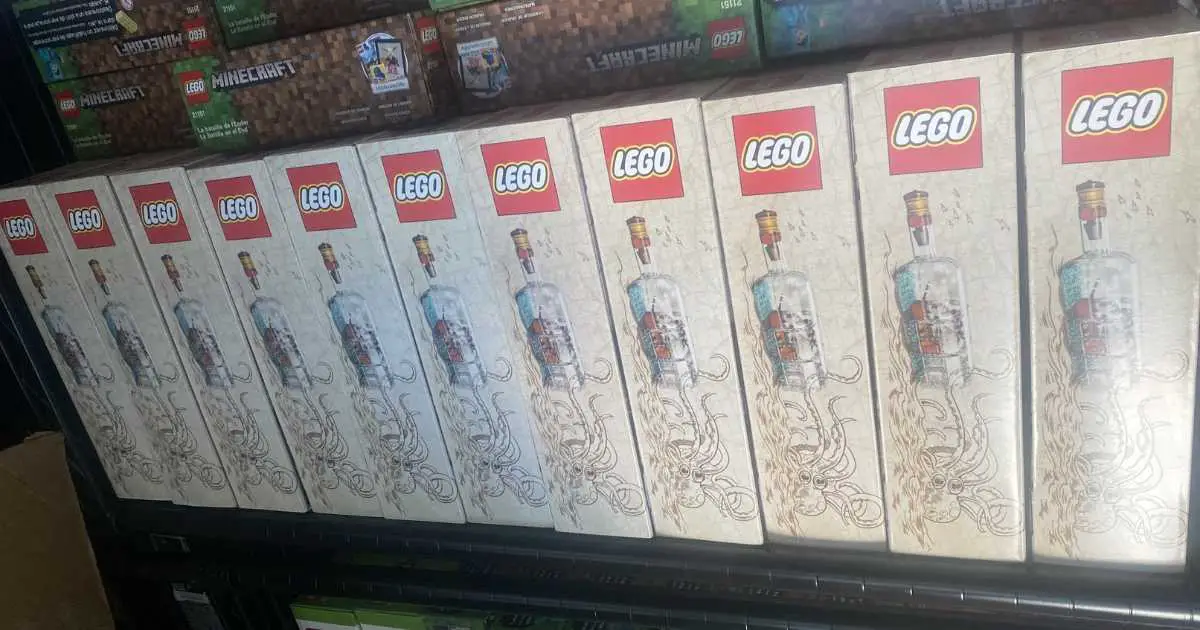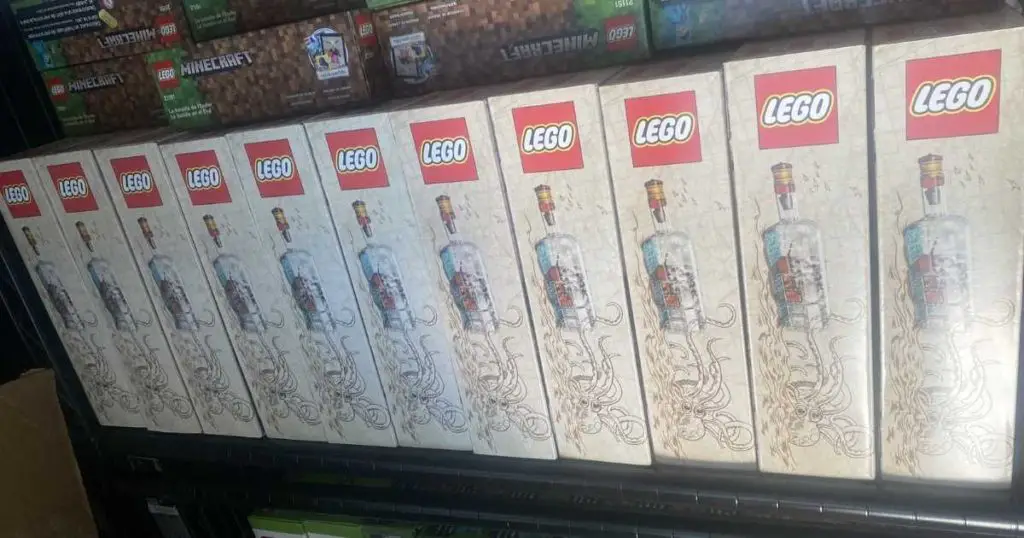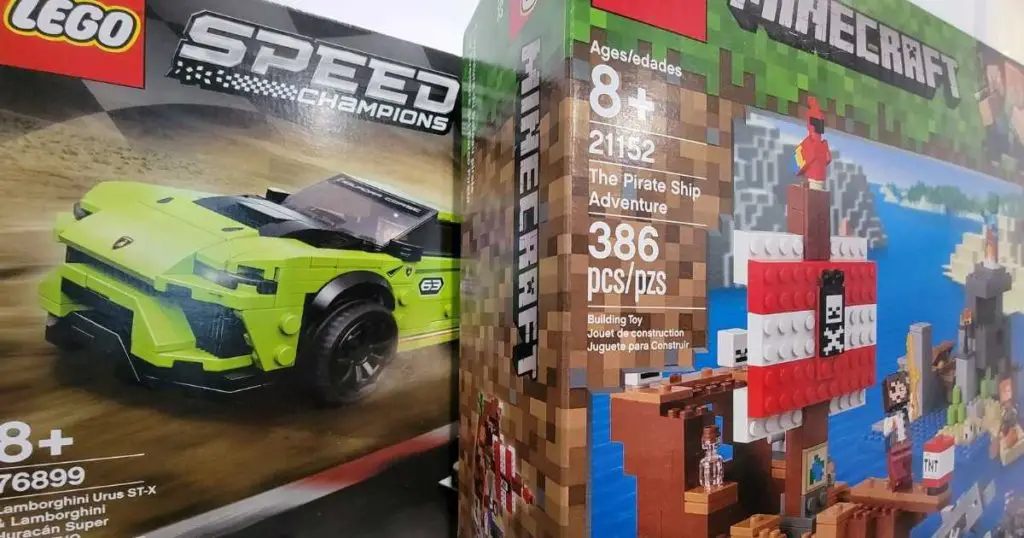
Every LEGO set has a limited production life, meaning that LEGO will eventually stop producing it. When production is stopped, we call that set a retired set. Once a LEGO set is retired and no longer available on retail shelves, there is a good chance that the only place you are going to be able to find it is the secondary market. But what if a retired set is very popular, even after retirement? Do some LEGO sets come out of retirement?
Some LEGO sets do come out of retirement, but it is not common. Some examples include the LEGO Ideas Ship in a Bottle 21313 and Saturn V Rocket 21309, both of which retired at the end of 2019 and were then re-released during 2020 with a different set number. LEGO Group made very minimal adaptations to the actual set, box or instructions. These are examples of re-releases, or sets coming out of retirement.
Sometimes, LEGO Group instead chooses to redesign the set and release a remake of an original set. For example, Belle’s Castle from Beauty and the Beast has been released several times as a LEGO set in different forms (set numbers 43180, 41067, 43196). We have seen this many times, particularly with popular licensed sets such as the Star Wars Millennium Falcon, Harry Potter Hogwarts Express, and more. Since these involves some changes, they could be seen as remakes rather than re-releases, and these are different to sets coming out of retirement and being re-released in exactly the same form.
Is your investment truly going down the drain when LEGO reissues that set? That is not always the case! Let me further explain why and how you should tackle any challenges that arises when a LEGO set comes out of retirement.
What LEGO sets have been re-released?

A good example of a retired LEGO set being re-released is the 2021 UCS Tumbler 76240. While the version that was released in 2021 varies a bit from the original, it doesn’t vary by much. If we look at the details, the new version has an additional 180 pieces and costs $30 more. The minifigures are updated, but the design isn’t changed in a meaningful way. Many LEGO fans would consider this a re-release as opposed to a new version of the Tumbler. The differences are minimal, and few collectors who already own the older version would also buy the new one since it is so similar.
Another example of a re-release that we are going to look at is the Taj Mahal 10256. Originally released in 2008, this set was massive for the day with 5922 pieces. While the original retired at the end of 2010, the set made a surprising return in 2017 in set number 10189 with 5923 pieces. Again, this re-release cost some LEGO investors money as the value of the original declined.
One of the best examples of this is within the LEGO Ideas theme. At the end of 2019, LEGO Group retired both the 21309 Saturn V and the 21313 Ship in a Bottle. During 2021, both of these sets could be found on shelves under new set numbers. The price and piece count for each remained exactly the same as the previously released version. I can imagine there was more than one investor that was unhappy with that decision and more than one collector that seized their second chance to grab these fantastic sets.
Why are some LEGO sets re-released?
The most obvious reason that some LEGO sets are re-released is because of the demand from the community. Sometimes a set is so popular that LEGO Group decides to re-release the set, purely because of the demand and economic gain that’s possible from reproduction. This was the case for Ship in a Bottle and Saturn V, as the LEGO Group made an official statement to brand ambassadors announcing that the re-release was “due to popular demand” (Source).
LEGO Group wants to make new sets every year and keep the product fresh and innovative. Retiring sets is a part of that strategy. The retired LEGO sets are sets that have reached their end of life (EOL) production. Usually LEGO sets are typically available for a (short) period of time, and then they stop making them.
But if the demand is extremely high then there is a chance they would consider re-releasing a set.
Another big reason that a set would come out of retirement and get re-released is if it fits well with a new direction or strategy that LEGO Group are taking with their designs or themes. For example, a major focus for LEGO Group in recent years has been to target adult fans, and introduce adults into the world of building LEGO. Therefore, we have seen an increase in highly displayable LEGO sets that would sit nicely on the shelf in an office, game room or living area. Ship in a Bottle can be considered an amazing example of that strategy, and may fit nicely with the newer Botanical Collection sets such as Bonsai Tree or Flower Bouquet. This is a set that works well with their recent strategy.
Are re-released LEGO sets the same as the original sets?
While the true rerelease of a retired set is rare, LEGO Group often looks back at old sets and redesigns them with new parts and techniques. These may vary in any number of ways from the original, but the essence of the set remains the same. For example, if they see that mainly adults were interested in the set previous to the retirement, they might opt to increase the piece total and complexity of the rereleased set to target that untouched market of older LEGO enthusiasts. This method is certainly refreshing.
There are a ton of examples over the years, but the two examples we are going to discuss here are the Burrow from the Harry Potter theme and the UCS Millennium Falcon.
The LEGO Harry Potter Burrow has had two different iterations over the years, one released in 2010 and the second released in 2020. While the two are based on the same scene from Harry Potter and the Half-Blood Prince the newer set is certainly an improvement over the older set.
The original set contained 568 pieces, six minifigures (four unique), and retailed for $60. The 2020 version, 75980, contains 1047 pieces, eight minifigures (seven unique), and retails for $100. The overall aesthetic and the play features really shine through in the redesign.
When 10179, the UCS Millennium Falcon hit shelves on October 1st of 2007, it wasn’t the biggest set of all time, but it was enormous. At $499.99 with 5197 pieces, this was an early precursor to the large sets we see today. Fast forward 10 years, and on October 1st 2017, Lego released an updated version.
This time the set was the largest set ever released. The redesigned Falcon had an additional $300 on the price tag, a couple of thousand additional pieces, and the ability to either represent the sequel or original trilogy. This one, while similar to the ’07 version, stands on its own as one of the most iconic sets ever released.
What other examples are there of LEGO set remakes?
There are a lot of sets released that are similar to others in one way or another. What is old will be new again, and LEGO Group revisits sets for different reasons. Here are a few more times where the rereleased version of a set is close enough to impact the value of the previous version.
- Avenger’s Tower: The original Avenger’s Tower 76038, was released along with Avenger’s: Age of Ultron in 2015. In 2020 Lego released 76166, which is another Avenger’s Tower, which is similar in many ways but based on the comics.
- Kylo Ren’s Shuttle: There is no getting around it, the first 2015 version of Kylo Ren’s Shuttle 75104, was bad. It was completely the wrong color and didn’t have the correct functionality in the wings. The more accurate version, 75256, was released in 2019. Love or hate the sequels, this set is a great correction of the original and a fantastic build.
- Fiat 500: This is a newer concept that LEGO Group are trying – color swaps. The idea is that essentially one set is released in two different colors. In this case the 10271 Fiat 500 is blue and the 77942 version is yellow. Cool concept that will hopefully be explored more in the future.
- Ninjago Legacy: Ninjago may not get the attention it deserves from the adult LEGO community, but the idea behind the legacy line is fantastic. New sets, inspired by the original sets released years before.
Why don’t more old LEGO sets get re-released?

There are a handful of reasons that LEGO Group do not want to continuously re-release old sets, and instead would prefer to focus on fresh designs and expanding their catalog.
If LEGO Group would just relaunch every popular retired set they have, it would make their product lineup boring over time. LEGO Group is known for having realistic and ingenious models or designs. The brand’s core is cemented in creativity. Selling the same product over and over will seem lazy to fans, and many will lose interest.
The popularity of LEGO is driven largely by the creativity and fun of new fresh designs, coupled with a strong sense of collectability. Many people want to collect the new sets, which helps to drive repeat buying and long-term fans.
Another downside to re-releasing old sets for LEGO Group is that the demand for those sets needs to be extremely strong to make a re-launched set work. In 2001, they tried to relaunch some old sets from the 80’s by releasing them under the label “LEGO Legends”. This campaign did not run that well with kids because of the old and vintage looks of the LEGO sets, and how much had changed with the designs by that point.
This will likely remain true today if many older sets were re-released, because the designs in recent years have become much more advanced.
A third important consideration here is the logistics involved with re-releasing sets. LEGO Group have a limited amount of manufacturing capacity in their factories, and they mostly want to use those resources for new fresh designs that are more likely to sell in higher quantities. Likewise, retailers have limited shelf space, and if they use that shelf space for a re-released set, they won’t be able to put a new set on that shelf.
For these reasons and many others, it is rare that a set will be fully re-released without some improvements being made, and we will certainly never see all sets being re-released.
Will a LEGO re-release make the value go down?
If a LEGO set comes out of retirement and gets re-released, there is a high chance that the value of the old set will go down. This is the case where the re-released set is almost an identical copy of the original.
When the set is available in retail stores again, many people who want to buy that set will buy directly from retail stores instead of going to third party sellers on eBay or Amazon. The design is practically the same after all.
As a result, third party sellers who have that set in their inventory would be faced with the choice of either holding onto it for longer until the new version is retired, or selling the old version at a reduced price so as to compete with the new version that is readily available in stores.
Since every seller will be weighing those options, many will engage in a price war, and the market price on the original set will likely drop.
This is luckily only really the case if it is a straight re-release. In the circumstance that the set is remodeled or redesigned , there are occasions that the value of the older and original set may not be negatively impacted at all.
If the new design is a downgraded version of the original LEGO set or the design does not live up to the standard, the original set may even get a boost to the value over time!
Is a re-released set a good investment?
To evaluate if a LEGO set is a good investment, you always need to keep an eye on the supply and demand of the set. If the re-release will be available for a short time frame or a fixed amount of sets will be produced, then the supply may be low and it might be worthwhile to pick up the new set as an investment, as long as it is selling well.
On the contrary, if the new re-released set looks as though it will have a very long shelf life, this could mean there will be a lot of supply in the aftermarket, which could mean that the value doesn’t increase as quickly as some other opportunities.
Many fans who wanted the set will have bought one by the time the set will retire again, and many LEGO investors will also have had a lot of time to buy the set, so supply may be high and demand may be low. This is just one factor that we need to consider when picking great LEGO investments, of course.
If you are considering buying LEGO sets as an investment, check out this article we wrote about the top misconceptions with LEGO investing.
Final Thoughts
There are some LEGO sets that will always have some sort of presence on shelf. Some things just have too much cultural relevance to be ignored. LEGO Group will always have need for them in the lineup.
As long as Harry Potter is a theme, a Hogwarts Express is surely just a few years away. As long as Star Wars is around, you can only go so long without an X-Wing or a Luke’s Landspeeder. When considering to buy a set or not there are a lot of factors to consider. No matter what your endgame is, you should be aware of the potential for Lego to release something that could impact resale value down the line.
LEGO sets coming out of retirement without any changes or improvements is not an everyday thing, but as LEGO investors, fans and collectors, we should be aware that it can happen.
